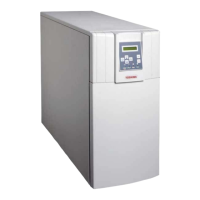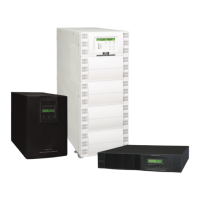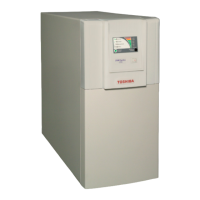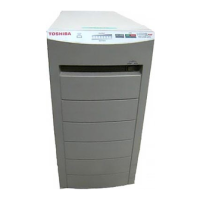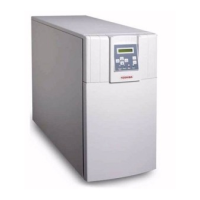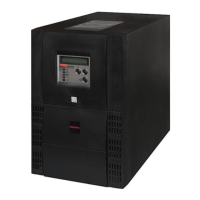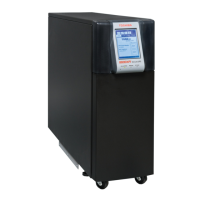
Do you have a question about the Toshiba 1600XPi SERIES and is the answer not in the manual?
Explains safety alert, prohibited, mandatory, ground, and hazard symbols.
Defines DANGER, WARNING, CAUTION, NOTICE signal words for hazard communication.
Notes FCC Class A and EMC Directive Class A compliance for the UPS.
Lists applications where the UPS should not be used due to safety risks.
Defines qualifications and responsibilities for personnel operating the UPS.
Procedure for checking the UPS for shipping damage upon receipt.
Steps to check the unit for damage after removing it from packaging.
Guidelines for proper storage conditions and maintenance of the UPS.
Instructions for environmentally responsible disposal of UPS components.
Wiring details for terminal blocks used with 208/240V input and output.
Wiring details for terminal blocks used with 240V input and 100/200V output.
Explains the function and connection of Emergency Power Off and Remote Shutdown.
Recommendations for wire size and torque for I/O connections.
Describes how external battery cabinets connect to the UPS.
Describes the intended applications and features of the 1600XPi Series UPS.
Lists the output capacities and ratings for various 1600XPi UPS models.
Explains the UPS's role in providing backup power during electrical interruptions.
Details how the UPS conditions power and protects connected equipment.
Describes power flow when the UPS is in bypass due to overload or fault.
Explains the UPS operation in the normal On-Line (double conversion) mode.
Details the power flow during battery backup mode when AC input fails.
Explains the function and connection of the Emergency Power Off safety feature.
Illustrates factors affecting battery backup time and discharge characteristics.
Lists voltage thresholds for battery alarms and automatic shutdown.
Describes the graphical representation of the UPS battery recharge cycle.
Outlines procedures for performing automatic and manual battery tests.
Guides through the initial setup and configuration of UPS parameters.
Details settings for internal and external battery configurations and runtimes.
Instructions for starting the UPS in its normal On-Line operating mode.
Procedures for safely stopping the UPS operation and entering bypass mode.
Identifies components on the UPS front panel, including display and control keys.
Explains manual controls like Run/Stop switches, reset, and contrast adjustment.
Describes the default opening screen, status indicators, and navigation.
Details the function of various touch-sensitive keys for UPS operation.
Explains the meaning of status indicators like load percentage and UPS status.
Describes the behavior and significance of the front panel LEDs.
Illustrates the menu structure and navigation paths for the touchscreen.
Explains the use of the alphanumeric keypad for entering data and passwords.
Details security levels, user login, and password management.
Provides steps to reset the Administrator password for system access.
Graphical power flow diagram showing UPS status and sections.
How to access and view detailed parameters for different UPS sections.
Displays parameters for internal and external battery sets, including voltage and current.
Guides on how to modify UPS operational parameters via the touchscreen interface.
Lists parameters accessible in the Settings tab and their access levels.
Procedure to refresh touchscreen calibration for accurate input response.
Describes the DB9 connector and pin assignments for remote signaling functions.
How the UPS LAN shutdown signal affects network systems and timing.
Details the usage and pin assignments of the RS-232C serial communication port.
Information about the network card for remote UPS management via SNMP and HTTP.
Describes the Environmental Monitoring Device for remote monitoring of environmental conditions.
Describes power flow and instructions for using the internal maintenance bypass.
Wiring details and usage instructions for a two-breaker external maintenance bypass unit.
Wiring details and usage for a three-breaker external bypass without a transformer.
Wiring details and usage for a three-breaker external bypass with a transformer.
Schematic showing the locations of electrical protection devices within the UPS.
Charts detailing the UPS response to common fault conditions.
Lists possible fault messages, their meanings, and required actions.
Lists warning messages, their meanings, and recommended actions.
Displays messages indicating changes in the UPS operating mode.
Displays messages indicating changes in the UPS operational status.
Basic maintenance procedures recommended for UPS users to ensure longevity.
Instructions for safely cleaning the touchscreen display to maintain visibility.
Guides on replacing internal UPS battery packs, including hot-swapping procedures.
Recommended intervals for periodic replacement of UPS components like fans and capacitors.
Specifies conduit knock-out hole sizes for various UPS models.
Lists the unit and shipping weights in pounds and kilograms for different UPS models.
Provides detailed physical dimensions (height, width, depth) for various UPS models.
Diagrams illustrating the physical layout of UPS units from different views.
Detailed technical specifications for UPS models ranging from 3.6 to 10 kVA.
Detailed technical specifications for UPS models ranging from 14 to 22 kVA.
Detailed technical specifications for the 5.2 kVA UPS model.
Parameters related to UPS model, serial number, firmware, and boot loader versions.
Parameters related to input voltage, current, frequency, and power factor settings.
Parameters related to output voltage, current, frequency, and power factor settings.
Settings for battery capacity, charging, temperature, and discharge levels.
Parameters for UPS operation, security levels, startup modes, and communication settings.
Parameters related to UPS testing, calibration, and status monitoring functions.
Physical dimensions and weight information for the 3.6 kVA UPS model.
Physical dimensions and weight information for the 5.2 and 6 kVA UPS models.
Physical dimensions and weight information for the 8 and 10 kVA UPS models.
Physical dimensions and weight information for the 14, 18, and 22 kVA UPS models.
Estimated runtimes for 3.6 kVA UPS with internal and external battery configurations.
Estimated runtimes for 6 kVA UPS with internal and external battery configurations.
Estimated runtimes for 8 kVA UPS with internal and external battery configurations.
Estimated runtimes for 10 kVA UPS with internal and external battery configurations.
Estimated runtimes for 14 kVA UPS with internal and external battery configurations.
Estimated runtimes for 18 kVA UPS with internal and external battery configurations.
Estimated runtimes for 22 kVA UPS with internal and external battery configurations.
Outline drawing showing dimensions of 3.6-6 kVA matching battery cabinets.
Outline drawing showing dimensions of 8-22 kVA matching battery cabinets.
Estimated backup times for non-matching battery cabinets at rated load.
Outline drawings showing relative sizes of non-matching battery cabinets.

